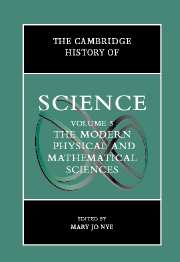Book contents
- Frontmatter
- Introduction: The Modern Physical and Mathematical Sciences
- Part I The Public Cultures of the Physical Sciences After 1800
- Part II Discipline Building in the Sciences: Places, Instruments, Communication
- Part III Chemistry and Physics: Problems Through the Early 1900s
- Part IV Atomic and Molecular Sciences in the Twentieth Century
- Part V Mathematics, Astronomy, and Cosmology Since the Eighteenth Century
- 23 The Geometrical Tradition: Mathematics, Space, and Reason in the Nineteenth Century
- 24 Between Rigor and Applications: Developments in the Concept of Function in Mathematical Analysis
- 25 Statistics and Physical Theories
- 26 Solar Science and Astrophysics
- 27 Cosmologies and Cosmogonies of Space and Time
- 28 The Physics and Chemistry of the Earth
- Part VI Problems and Promises at the End of the Twentieth Century
- Index
- References
26 - Solar Science and Astrophysics
from Part V - Mathematics, Astronomy, and Cosmology Since the Eighteenth Century
Published online by Cambridge University Press: 28 March 2008
- Frontmatter
- Introduction: The Modern Physical and Mathematical Sciences
- Part I The Public Cultures of the Physical Sciences After 1800
- Part II Discipline Building in the Sciences: Places, Instruments, Communication
- Part III Chemistry and Physics: Problems Through the Early 1900s
- Part IV Atomic and Molecular Sciences in the Twentieth Century
- Part V Mathematics, Astronomy, and Cosmology Since the Eighteenth Century
- 23 The Geometrical Tradition: Mathematics, Space, and Reason in the Nineteenth Century
- 24 Between Rigor and Applications: Developments in the Concept of Function in Mathematical Analysis
- 25 Statistics and Physical Theories
- 26 Solar Science and Astrophysics
- 27 Cosmologies and Cosmogonies of Space and Time
- 28 The Physics and Chemistry of the Earth
- Part VI Problems and Promises at the End of the Twentieth Century
- Index
- References
Summary
During the nineteenth and twentieth centuries, astronomy has changed from a relatively homogeneous discipline to one of tremendous diversity. Before this period, the main business of astronomy had been the measurement and prediction of planetary motion and stellar position. Earlier astronomers depended on a limited range of observational equipment – the optical telescope and various instruments for measuring angles and positions against the sky – in order to map the locations of the stars and to track the motions of the planets as they wandered against this fixed background. By the early nineteenth century, astronomers had, as theoretical tools, not only Newtonian gravitation but also the fruits of a century’s further refinement of celestial mechanics. Not only could astronomers calculate the orbits of individual planets around the Sun; they could also investigate the mutual perturbations of the various bodies and the stability of the solar system as a whole, far into the future. Within their well-defined realm, early-nineteenth-century astronomers congratulated themselves on possessing a predictive power exceeding that of all other fields of natural science.
Yet astronomers were eventually to trade their sure grasp of their traditional portion of the world for a much less certain hold on broad, new domains: the study not just of position and motion but also of the physical nature of celestial objects of all kinds, from the Sun, stars, and planets to nebulae and galaxies. This expansion of subject was, in significant part, technology driven, and many new observational technologies contributed to making it possible, including the building of telescopes with tremendously increased light-gathering power and finer resolution, and the introduction of photography as an astronomical tool.
- Type
- Chapter
- Information
- The Cambridge History of Science , pp. 505 - 521Publisher: Cambridge University PressPrint publication year: 2002



